LisbonLisboaPortugal.com
The best independent guide to Lisbon
LisbonLisboaPortugal.com
The best independent guide to Lisbon
Lisbon in April; Is it a good month to visit?
To understand April in Lisbon, you only need to know one Portuguese saying: 'Abril, águas mil,' or 'April, a thousand waters.' This perfectly captures the reality of spring in the capital, a month when intense Atlantic showers alternate with bright, sunny periods in an unpredictable dance.
Despite the changeable weather, April brings a palpable shift in the city's energy. As the shoulder season begins, Lisbon shakes off its winter quietude and feels noticeably busier and more vibrant. Visitor numbers climb, particularly around Easter, bringing both higher prices and a livelier atmosphere to the streets and sights. When the sun does appear between showers, the conditions are often perfect for exploring, neither too hot nor too cold, with the city looking fresh and gleaming after the rain.
Making the most of April hinges on flexibility. A well-planned trip embraces the month's dual nature, mixing indoor pursuits like museums and markets with outdoor adventures seized when the weather cooperates. The key is not fighting April's temperament but working with it. This guide will help you navigate both the sunshine and the showers, ensuring you capture the best of early spring in Lisbon.
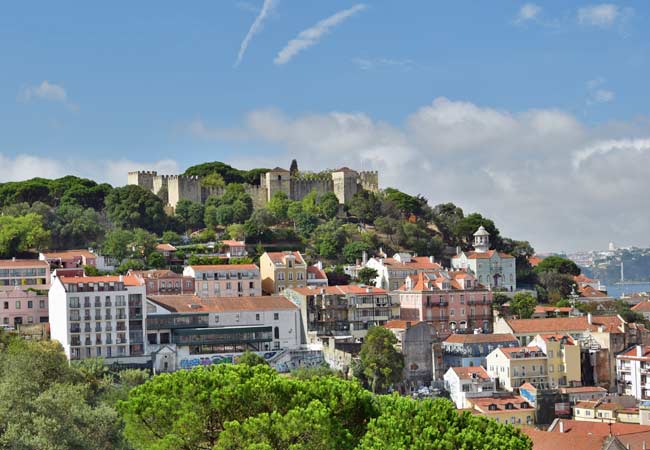
April brings the first pleasant weather of the year, making it an ideal time to explore São Jorge Castle.
Lisbon Weather in April
April in Lisbon is a month of dramatic contrasts, where intense spring showers can give way to beautiful sunny days ideal for sightseeing.
On average, daytime temperatures climb to 20C (68F), with a nighttime minimum of 12C (53F). The city enjoys over eight hours of sunshine a day, but April can also be one of the wettest months of spring, with an average of 13 days of rain contributing to 67mm of precipitation.
These monthly averages, however, can mask the true nature of April's weather. Its defining feature is intensity, with conditions changing rapidly. While a single spell of rain rarely lasts for more than a couple of days, the showers that do occur can be sudden and heavy. These downpours often pass quickly, replaced by brilliant sunshine that hints at the summer ahead.
For visitors, this means experiencing the full spectrum of spring weather. This duality makes April a rare month where having both an umbrella and sunscreen close at hand is a wise approach.

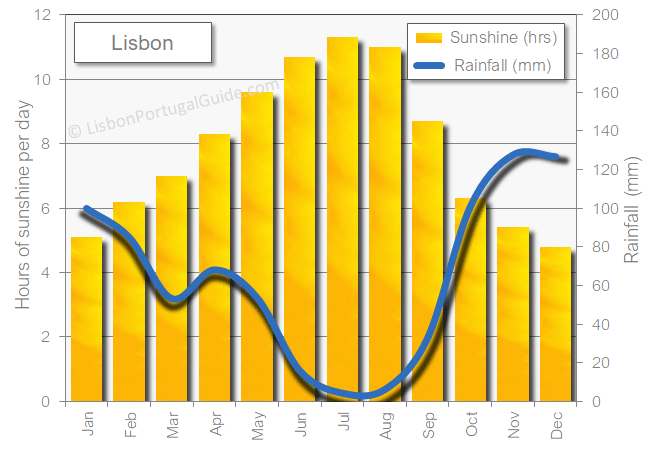
Highlights of Lisbon in April
With the city bursting into spring, April is the perfect time for a varied itinerary. Here are some of the best things to do in Lisbon, whether the sun is shining or you're dodging a spring shower:
• Alfama district: With the city bursting into spring, April is the perfect time for a varied itinerary. Here are some of the best things to do in Lisbon, whether the sun is shining or you're dodging a spring shower - Alfama guide.
• Tram 28: Board the classic yellow tram for a rattling journey through the city’s most picturesque districts. Th route navigates tight corners and steep hills, offering a unique perspective of Lisbon's historic centre. - Tram 28 guide.
• Sintra day trip: Take a short train ride to the enchanting town of Sintra, a landscape of fairytale palaces and mystical gardens. The colourful Pena Palace and the mysterious Quinta da Regaleira are essential visits, set amongst the region's lush, green hills.- Sintra day trip guide.
• Belém district: Visit the grand riverside district dedicated to Portugal's Age of Discovery. Here you can explore the magnificent Jerónimos Monastery and the iconic Belém Tower, and sample the original Pastéis de Belém, whose secret recipe dates back to 1837. - Belém district guide.
• TimeOut Market: Experience the best of Lisbon's modern food scene at this bustling gourmet market. It brings together dozens of the city’s top chefs and restaurants, making it the perfect place to sample a wide variety of Portuguese and international cuisine.
• Elegant Chiado: Explore the sophisticated Chiado district, known for its elegant 19th-century architecture, upscale boutiques, and historic bookshops. It's the perfect neighbourhood to wander, and should a spring shower arrive, its charming heritage cafés offer a welcome refuge.
• Miradouros (Viewpoints): Lisbon's hillside viewpoints are an essential stop on a sunny day. Terraces such as the Portas do Sol and Senhora do Monte offer expansive views over the city's rooftops and have kiosk cafés perfect for enjoying a drink in the sun.
• Bairro Alto Nightlife: As dusk falls, experience the transformation of the Bairro Alto neighbourhood. The steep, quiet streets come alive, with dozens of small, eclectic bars opening their doors and patrons spilling out onto the cobbles to create one of Europe’s most vibrant street-party atmospheres.- Lisbon nightlife guide.
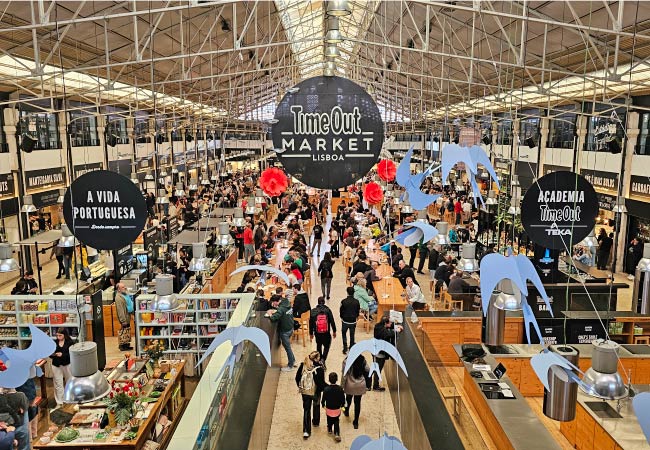
Freedom Day – 25th April
On April 25th, Portugal celebrates Freedom Day (Dia da Liberdade), a national holiday commemorating the 1974 Carnation Revolution. This largely bloodless coup successfully overthrew the authoritarian Estado Novo regime, ushering in an era of democracy. The revolution's name comes from the powerful image of soldiers placing carnation flowers in their rifle barrels, a symbol of their peaceful intent.
The anniversary is marked with significant festivities in Lisbon, reflecting on this defining moment in modern Portuguese history. The city hosts a military parade on the grand Avenida da Liberdade, while a large concert takes place in Praça do Comércio on the eve of the holiday. As a lasting tribute, Lisbon's suspension bridge was renamed from the Salazar Bridge to the Ponte 25 de Abril, forever cementing the date into the fabric of the nation.
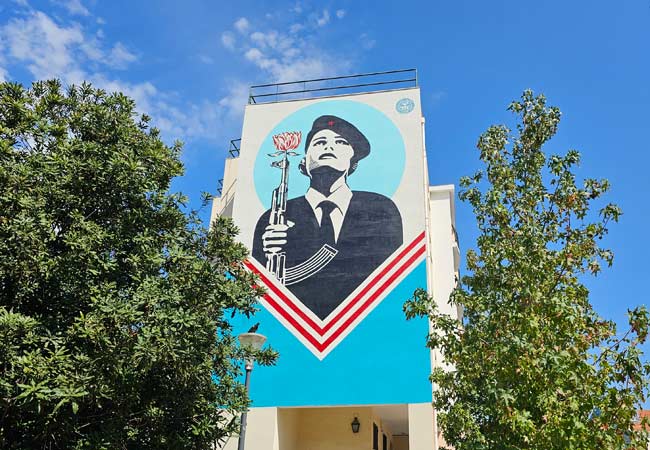
The Peace Guard mural in the Graça neighbourhood, commemorating the events of the revolution.
What to do in Lisbon when it rains in April
A rainy day is the perfect opportunity to explore Lisbon's outstanding indoor attractions.
The Museu Calouste Gulbenkian holds a world-class private collection spanning from ancient Egyptian artifacts to Impressionist art. For a uniquely Portuguese experience, the Museu Nacional do Azulejo reveals the country's beautiful tile-making history in a former convent. The Museu Nacional dos Coches (Coach Museum) presents a spectacular collection of ornate royal carriages. The magnificent Oceanário de Lisboa is a world-class aquarium, with five giant tanks representing the world oceans.
Shopping provides another excellent escape from the weather. For hundreds of stores under one roof, head to the large Colombo Shopping Centre. For a more traditional experience, explore the elegant boutiques and historic bookshops of the Chiado district. Finally, a wet day is the best time to find a seat on the famous Tram 28, watching the city’s oldest neighbourhoods slide by from the dry comfort of your window.
For a more interactive experience, the immersive Quake museum vividly recreates Lisbon's great earthquake of 1755 through impressive exhibits. You could also spend an afternoon at the LX Factory, a creative hub where former warehouses shelter independent design shops, art galleries, and unique restaurants. Another great option is joining a Portuguese cooking class, where you can learn the secrets behind local dishes or master the art of the perfect pastel de nata.
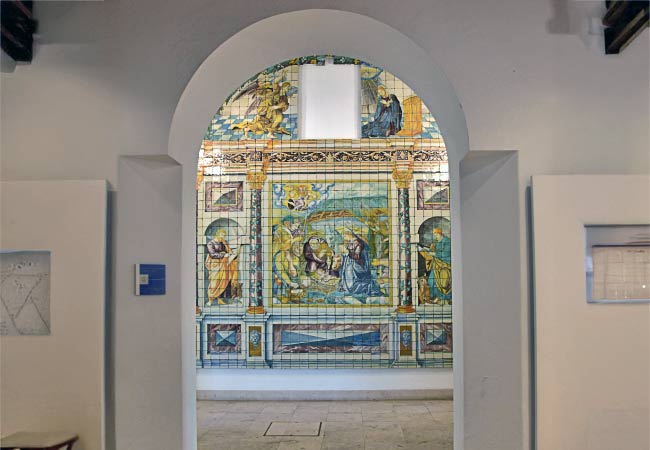
The fascinating Museu Nacional do Azulejo

The central tank of the Oceanário de Lisboa
Have you booked your hotel yet?
April represents excellent value for visiting Lisbon, but securing accommodation early ensures you get the best rates and locations.
Use the interactive map below to explore available accommodation across Lisbon's different neighbourhoods. Simply adjust the dates to match your travel plans, and the map will show current availability and pricing for your stay:
Booking.comEaster (Páscoa)
Unlike the grand public processions found in many Catholic countries, Easter in Portugal is primarily a family-focused occasion centred on traditional meals and gatherings. The atmosphere in Lisbon is therefore more subdued than celebratory, with the city observing the religious period quietly.
For visitors, the main impact will be the national holidays of Good Friday (Sexta-feira Santa) and Easter Sunday. While most restaurants, cafés, and shops in the main tourist areas remain open, many of the national museums and monuments will either close or operate on reduced holiday schedules. It is essential to check the opening times for any specific attractions you plan to visit over the Easter weekend.
A key part of the celebration that you will see is the traditional Easter bread, the Folar de Páscoa. In the weeks leading up to Easter, bakery windows across the city are filled with these distinctive cakes, which can be either sweet or savoury and often contain a whole hard-boiled egg baked into the crust.
Sintra in April
Sintra's microclimate is particularly pronounced in April. This is largely due to moisture-laden winds blowing in from the Atlantic. As they are forced up and over the cool, damp Serra de Sintra, the moisture condenses, resulting in sudden, intense downpours that can leave the hills drenched, even when Lisbon only experiences light cloud cover.
Therefore, a successful trip to Sintra in April relies on having a flexible itinerary. Monitor the weather forecast throughout your stay in Lisbon and reserve the clearest, driest day for your trip to the hills. The reward is seeing Sintra’s magnificent gardens in full bloom under the sun; the alternative is getting caught in a drenching shower that can spoil the entire experience.
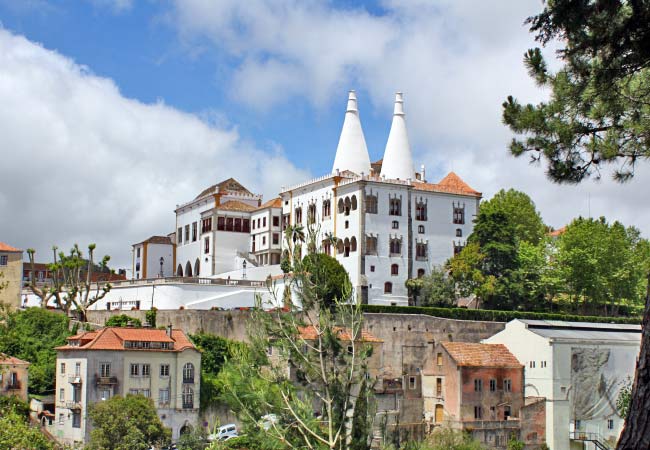
Only head to Sintra on dry day
A Suggested Itinerary for an April Holiday to Lisbon
This 5 day itinerary has been designed with April's changeable weather in mind, balancing outdoor exploration with indoor cultural attractions. The schedule covers Lisbon's essential historical sites alongside local experiences and modern districts. Plan your Sintra day trip for the sunniest weather forecast.
Day 1: The Historic Heart of Alfama and Baixa
The first day is dedicated to exploring Lisbon's oldest and most characterful neighbourhoods. April's pleasant spring weather is ideal for a day of walking that begins at the city's highest point before descending through medieval alleys into its grand, neoclassical downtown.
The morning begins with an ascent to the Castelo de São Jorge. From its commanding position, the ancient walls offer a perfect introduction to the city, with panoramic views across the historic centre and the Tagus River. From here, descend into the labyrinthine streets of Alfama, Lisbon's oldest district. This atmospheric maze of steep, cobbled alleys and hidden courtyards is best explored on foot. Along the way, you will discover the imposing, fortress-like Lisbon Cathedral (Sé de Lisboa) and picturesque viewpoints such as the Miradouro da Graça, where vibrant bougainvillea often frames the city views in spring.
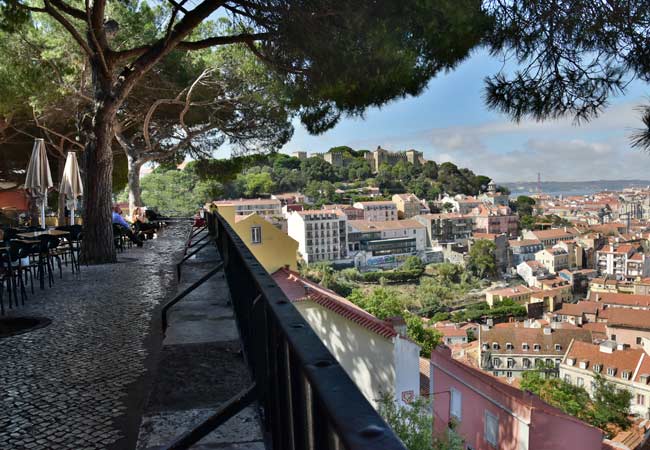
In the afternoon, the exploration moves from Alfama’s medieval character to the grand, orderly grid of the Baixa district. Completely rebuilt after the devastating 1755 earthquake, this area is defined by its elegant Pombaline architecture. Its central hub, Rossio Square, is a bustling public space known for its wave-patterned pavement and baroque fountains. A remarkable piece of 19th-century industrial art, the ornate Elevador de Santa Justa, connects the lower Baixa with the upper Chiado district and provides a unique perspective over the area.
The district’s main pedestrian artery, Rua Augusta, is a lively street that leads towards the river through a majestic triumphal arch. This opens onto the magnificent Praça do Comércio, a vast square that serves as a monumental gateway between the city and the river. The day's exploration can be concluded with a visit to a historic bar like 'A Ginjinha' for a taste of the traditional sour cherry liqueur, an authentic Lisbon ritual.
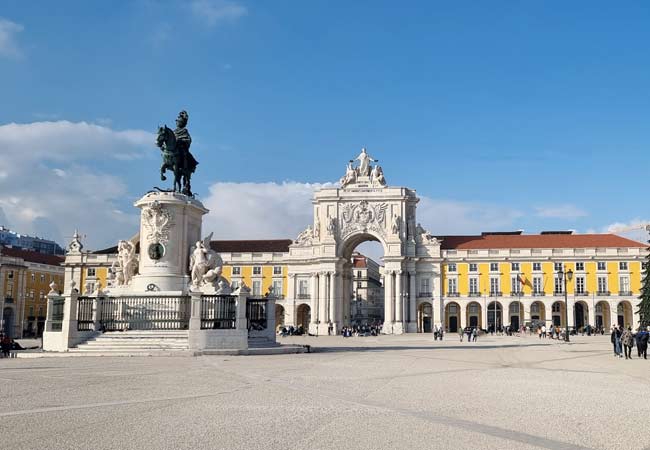
Day 2: Maritime Grandeur and Modern Creativity
This day is dedicated to the waterfront districts of Belém and Alcântara, where Portugal's celebrated Age of Discoveries meets Lisbon's contemporary creative spirit. The mild April climate is perfectly suited for exploring the open, riverside monuments that define this historic area.
The journey begins in Belém at the Jerónimos Monastery, the district’s monumental centerpiece and a UNESCO World Heritage site. Its elaborate Manueline stonework, funded by the wealth of the spice trade, is a uniquely Portuguese architectural style. No visit is complete without a stop at the nearby Pastéis de Belém, the bakery that has produced the original custard tarts from a secret recipe since 1837. From here, a pleasant walk along the riverfront leads to the Padrão dos Descobrimentos, a towering monument honouring Portugal's great explorers, and finally to the iconic Belém Tower, the elegant 16th-century fortress that once guarded the estuary.

The Torre de Belém
In the afternoon, transition from the grandeur of the past to the creative energy of the present at the LX Factory in the Alcântara district. This repurposed industrial complex has become a vibrant hub for Lisbon's contemporary spirit, where former warehouses now house independent boutiques, artist studios, and innovative restaurants. It provides a fascinating look at the city's modern renaissance.
With the longer spring days, an ideal way to conclude the day is with a sunset boat tour on the Tagus. These excursions offer a unique perspective of the city's landmarks, allowing you to see the Belém Tower, the 25 de Abril Bridge, and the historic skyline illuminated by the golden light of the setting sun.
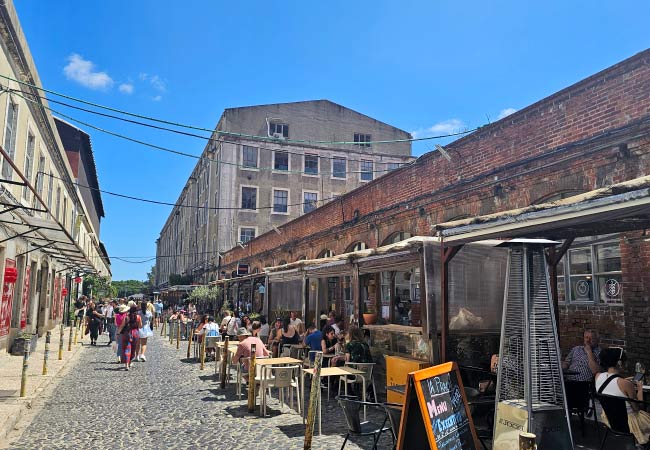
Day 3: The Fairytale Estates of Sintra
An excursion to Sintra is an essential part of any visit to Lisbon. It is a UNESCO World Heritage landscape of forested hills and fantastical palaces that served as a summer sanctuary for Portuguese royalty. It is highly recommended to plan this day trip for the day with the clearest weather forecast, as the spectacular views are a key part of the experience.
Given the sheer number of attractions and the hilly terrain, it is best to select two or three main sites to allow for a rewarding and unhurried exploration. The most iconic landmark is the Pena Palace, a vibrant Romanticist fantasy of whimsical architecture and bright colours perched atop the highest peak in the hills. Its opulent interiors and panoramic terraces offer breathtaking views across the entire region. Another primary destination is the Quinta da Regaleira, an enigmatic estate where the main allure is its symbolic gardens, filled with grottoes, hidden tunnels, and the famous initiation well that spirals deep into the earth.
Sintra offers several other magnificent treasures. The ancient fortifications of the Moorish Castle snake along a high mountain ridge, offering a more rugged, historical experience. In the centre of the historic town stands the Sintra National Palace, easily identified by its distinctive twin chimneys and notable as Portugal's best-preserved medieval royal residence. For those interested in botany and romantic architecture, the exotic, Arabian-inspired Monserrate Palace boasts acclaimed gardens that are particularly beautiful in the spring.
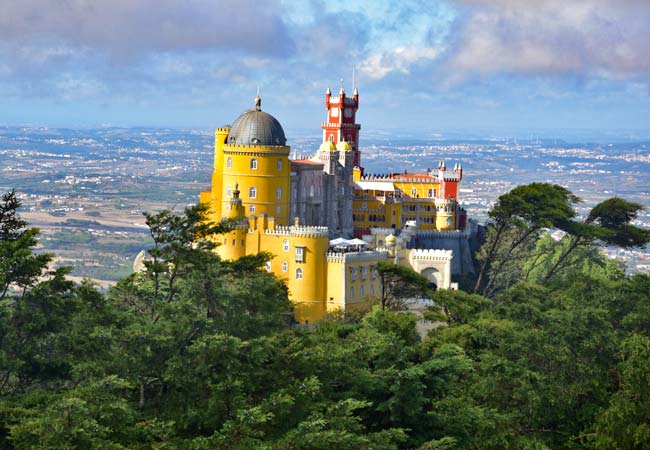
Day 4: Bohemian and Elegant Lisbon
This day is dedicated to exploring the authentic and fashionable neighbourhoods that sit high above the city centre, offering a journey through tranquil residential streets, elegant shopping districts, and Lisbon’s most famous nightlife quarter.
The day begins in the tranquil and refined neighbourhood of Estrela. This area provides a genuine taste of local life, centered around two magnificent landmarks. The grand, dome-topped Estrela Basilica is a masterpiece of late baroque and neoclassical architecture, while directly opposite, the lush Jardim da Estrela is a beautifully landscaped park and a favourite green space for Lisbon’s residents. It is a peaceful and authentic start to the day, away from the main tourist hubs.
From Estrela, the route continues into the fashionable district of Príncipe Real, known for its upmarket boutiques, concept stores, and antique shops. The neighbourhood’s elegant 19th-century buildings house some of the city's most innovative restaurants and cafés, making it an excellent area for lunch. This district seamlessly blends into the adjacent area of Chiado, Lisbon's traditional hub for culture and sophisticated shopping.
In the afternoon, explore the neighbouring Bairro Alto. While famous for its nightlife, its quiet daytime atmosphere is ideal for discovering its characterful grid of narrow streets. Here you can visit the Igreja de São Roque, a church whose modest exterior conceals a breathtakingly opulent baroque interior. As evening approaches, the area begins its daily transformation. A great place to start is the Miradouro de Santa Catarina, a popular viewpoint for watching the sunset over the river. After dark, Bairro Alto reveals its legendary character as dozens of small bars open their doors and a vibrant energy spills onto the cobbled streets. This is also one of the best areas to find an authentic Fado venue and experience Portugal's soulful traditional music.
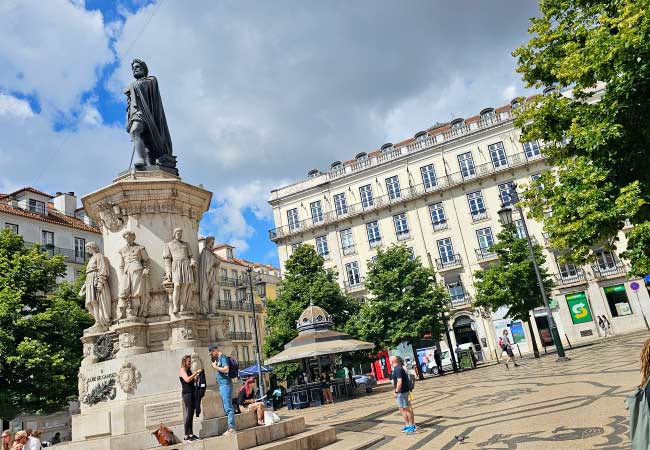
Day 5: South of the Tejo & Modern Marvels
The final day offers a fresh perspective on Lisbon, first by viewing the city from across the Tagus River and then by exploring its futuristic eastern waterfront. This journey showcases both the grand scale of Lisbon's landscape and its ambitious, forward-looking vision.
Begin the day by crossing the river on a ferry from the Cais do Sodré terminal to the town of Cacilhas on the southern shore. This area is famous for its excellent and authentic seafood restaurants that line the waterfront, offering a more local atmosphere and a great option for lunch. From Cacilhas, a short bus ride takes you up the hill to the base of the towering Cristo Rei (Christ the King) monument.
Inspired by the famous statue in Rio de Janeiro, the main reason to visit Cristo Rei is to experience the unparalleled panoramic view from its observation deck. From this high vantage point, the entire city of Lisbon is laid out across the water, offering a magnificent perspective on the sweep of the 25 de Abril Bridge and the city's historic skyline, from the hills of Alfama to the monuments of Belém.
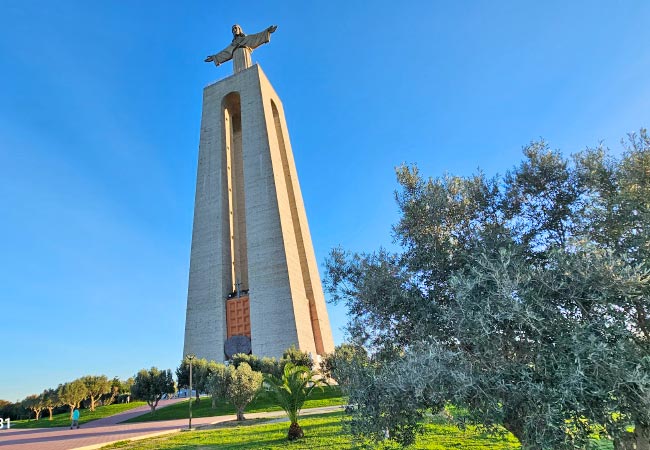
In the afternoon, travel from the southern shore to the city's futuristic eastern edge at Parque das Nações. This district, the legacy of the 1998 World Expo, provides a striking contrast to historic Lisbon with its bold contemporary architecture, public art, and waterfront gardens. The main attraction here is the spectacular Oceanário de Lisboa, one of Europe's most impressive aquariums and a perfect activity regardless of the weather. The area is also defined by landmarks such as the Calatrava-designed Oriente Station and the vast Vasco da Gama Bridge, providing a memorable and modern finale to your Lisbon journey.
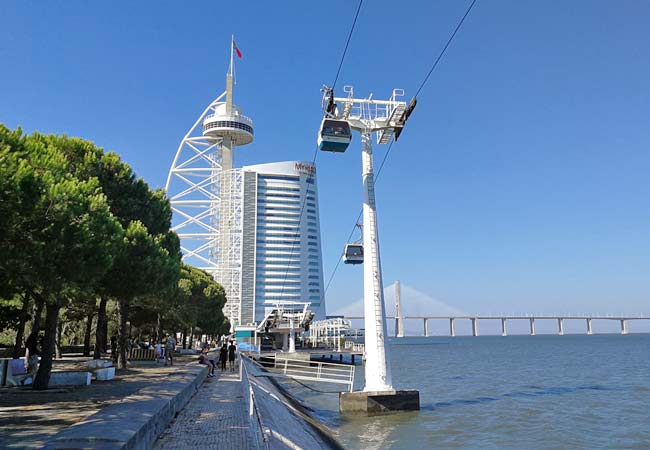
Finding bargain flights and accommodation in April
April's transitional season presents excellent opportunities for securing budget-friendly flights and accommodation deals.
Flight booking requires both advance planning and flexibility. Securing flights at least three months ahead provides access to the best prices, while choosing Tuesday through Thursday departures can yield substantial savings.
April proves ideal for securing accommodation bargains, particularly in mid-range and luxury hotels. Properties often introduce last-minute promotions or special offers to maintain occupancy levels, with discounts frequently reaching 30-40% off standard rates. These deals demand patience and thorough comparison shopping across multiple booking platforms to identify the best opportunities.
Booking fully refundable rooms provides valuable flexibility, allowing travellers to take advantage of better deals that may emerge closer to their travel dates. This approach requires active monitoring but can result in significant savings for those willing to invest the time.
What to pack for a holiday to Lisbon in April
When packing for Lisbon in April, it's important to consider the city's mild but variable spring weather. To stay comfortable, focus on layering: pack lightweight, breathable items such as t-shirts, long-sleeve shirts, and a medium-weight sweater or cardigan. A waterproof or light raincoat is essential for the occasional showers. For bottoms, comfortable jeans or trousers are suitable, and towards the end of April.
Footwear should prioritize comfort and versatility, as Lisbon's cobbled streets and hills can be challenging to navigate. Comfortable walking shoes, preferably waterproof, are a must, and you might want to include a pair of more formal shoes for evening outings. Lisbon's nightlife and dining scenes are vibrant yet relaxed, so pack a smart-casual outfit for these occasions.
Discover more of Lisbon with our most popular guides
If you've found our content valuable, we'd welcome your support.
The digital publishing landscape has evolved significantly. As a small independent publisher, we face growing challenges. Search engines increasingly favour paid content over organic results, while AI-generated content often reproduces original work without attribution.
To support our work, please consider bookmarking this page (press Ctrl + D) for quick access. If you find an article helpful, we'd be grateful if you'd share it with friends on social media.
For specific questions, please see our Reddit community at r/LisbonPortugalTravel.
Should you notice any outdated or incorrect information, please contact us at [email protected]
Thank you for helping us continue to provide valuable content in an increasingly challenging digital environment.
A complete list of all of our Lisbon articles
If you've found our content valuable, we'd welcome your support.
The digital publishing landscape has evolved significantly. As a small independent publisher, we face growing challenges. Search engines increasingly favour paid content over organic results, while AI-generated content often reproduces original work without attribution.
To support our work, please consider bookmarking this page (press Ctrl + D) for quick access. If you find an article helpful, we'd be grateful if you'd share it with friends on social media.
For specific questions, please see our Reddit community at r/LisbonPortugalTravel.
Should you notice any outdated or incorrect information, please contact us at [email protected]
Thank you for helping us continue to provide valuable content in an increasingly challenging digital environment.



































